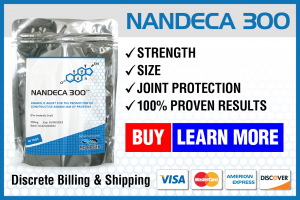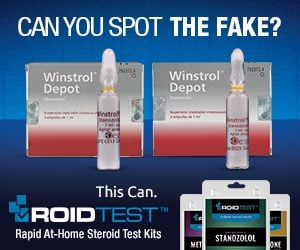Deca-Durabolin is an anabolic steroid that is considered to be quite ‘mild’ by many in terms of its side effects. However, the term ‘mild’ is often used too liberally and is a very broad and vague label to give to any anabolic steroid. The truth of the matter is that Nandrolone does possess some ‘mild’ attributes but also some ‘harsh’ properties as well. It must be understood first and foremost that Deca-Durabolin side effects include side effects that are unique to Nandrolone and unseen with nearly all other anabolic steroids (with the exception of its brother compound, Trenbolone, which shares many of the exact same side effects and properties).
One must understand above everything that Nandrolone lacks the 19th carbon that Testosterone possesses, which makes it a Progestin and it has been demonstrated that 19-nor anabolic steroids tend to exhibit binding affinity for the Progesterone receptors in the body[1]. As mentioned above, this presents some issues that are not commonly seen with other anabolic steroids that are not Progestins. Nandrolone is considered to possess moderate Progestogenic activity. Progestogenic side effects are almost identical to Estrogenic side effects, and they include: severe endogenous Testosterone production shutdown/suppression, gynecomastia, and water retention. It has been discovered that the activity of Progestins is closely correlated with the activity of Estrogen in the body. There also exist some side effects associated with Progestins that are not seen in other anabolic steroids.
19-nors being Progestogenic compounds are known to increase a hormone in the body known as Prolactin. Prolactin levels above normal in men often results in side effects such as lactating nipples, erectile dysfunction, anorgasmia (inability to achieve orgasm) and endogenous Testosterone production suppression/shutdown. An interesting point to learn is the fact that Progesterone itself is known to inhibit Prolactin production, and that 19-nors such as Nandrolone and Trenbolone being classified as Progestins should serve to actually suppress Prolactin levels. However, this is not the case as Nandrolone and Trenbolone are not Progesterone themselves – they are anabolic steroids that exhibit Progestogenic activity due to their chemical modifications and it is therefore very possible for these hormones to exhibit activity that is contrary to the activity of a similar hormone or parent hormone. It has been found that Nandrolone and Trenbolone can and do in fact increase Prolactin levels in the body.
Prolactin increases can be controlled either with the use of Prolactin antagonist drugs (such as Cabergoline or Pramipexole), however, prevention of rising Estrogen levels are also an effective method. For one thing, it is strongly speculated that the Estrogen in fact serves as a co-binding factor in the Prolactin receptor expression (PRLR). This can increase an individual’s sensitivity to Prolactin even if Prolactin levels themselves are not high in the body. This is a very sound theory when it is understood that the Estrogen receptor is a causative factor in Prolactin issues. Therefore, controlling Estrogen levels should control the effects of Prolactin. This is the number one reason why the side effects associated with 19-nor compounds (such as Nandrolone and Trenbolone) are frequently reported to be far more pronounced and with greater severity when they are used in a high Estrogen environment (whether it is from stacking Nandrolone or Trenbolone with high aromatizable doses of an aromatizable compound, such as Testosterone or otherwise).
Estrogenic Side Effects
Deca-Durabolin side effects where Estrogen is concerned is considerably minor and very minimal. Nandrolone holds very low Estrogenic activity and binds very poorly with the aromatase enzyme (the enzyme responsible for the conversion of androgens into Estrogen). It is estimated that only approximately 20% of Nandrolone is converted into Estrogen in comparison with Testosterone’s conversion rates[2]. The cause of this is that as previously mentioned and covered, Nandrolone is a Progestin (as are all 19-nor compounds)[3]. The other major factor in this is the fact that Nandrolone can undergo Estrogen conversion in the liver, but other locations where there is a high rate of Estrogen conversion (such as fat tissue), Nandrolone is quite resistant[4]. Progestins are very resistant to Estrogen conversion, but the fact that Nandrolone is a Progestin presents various issues in and of itself, which has been covered in detail above.
Androgenic Side Effects
Deca-Durabolin possesses an androgenic rating of 37, which is known to be one of the lowest – if not the lowest – androgenic rating of all anabolic steroids. This is excellent news for females and any individuals that are sensitive to the androgenic side effects of anabolic steroids. In comparison, Testosterone’s androgenic strength is rated at 100. Although considered quite weak, androgenic side effects are still a possibility with the use of Deca Durabolin and potential androgenic side effects include: increased sebum secretion (oily skin), increased bouts of acne (linked to increased sebum secretion), bodily and facial hair growth, and the increased risk of triggering Male Pattern Baldness (MPB) in individuals that possess the genetic trait required for the condition to manifest itself. Virilization symptoms from Deca-Durabolin side effects are also a potential issue for females, which include: development of male characteristics (growth of body hair, deepening of the voice), clitoral enlargement, and menstrual irregularities. However, the incidence of these symptoms manifesting with sensible Nandrolone use in females is very minimal – but the risk still does exist.
HPTA and Endogenous Testosterone Production Side Effects
All anabolic steroids exhibit the side effect of endogenous Testosterone production suppression and/or shutdown. Deca-Durabolin side effects are no exception to this. It has been previously commonly (and wrongfully) expounded by many in the steroid using community that Nandrolone is an anabolic steroid that exhibits ‘mild’ HPTA suppression/shutdown. This could not be further from the truth, as there exist plenty of evidence and data to demonstrate that Nandrolone is in fact extremely and severely suppressive to the body’s natural endogenous Testosterone production. One study administered 100mg weekly of Nandrolone for a 6 week period to test subjects and the result was that of a 57% decrease in endogenous Testosterone levels, while another study administered 300mg weekly to test subjects resulting in an even higher 70% reduction in Testosterone levels[5]. Nandrolone is a far more severe HPTA suppressant than most other anabolic steroids, and this is owed in particular to the fact that Nandrolone by nature of its missing 19th carbon is a Progestin[6]. Compounds that are of a Progestogenic nature (such as Nandrolone and Trenbolone) exhibit far greater amounts of HPTA suppression than any other anabolic steroids.
Hepatotoxic Side Effects
Deca-Durabolin is not an oral C17 Alpha Alkylated anabolic steroid, and so there are no associated risks of hepatotoxicity with Deca-Durabolin.
Cariovascular Side Effects
It is well known that all anabolic steroids possess negative impacts on cholesterol levels in the human body. This involves the reduction of HDL (the good cholesterol) and increases of LDL (the bad cholesterol). The result of such changes involves an increased risk of arteriosclerosis, and the degree to which these changes occur for the worse are usually dose-dependent (with higher doses increasing the negative changes and the risks). Other factors that affect these negative cholesterol changes are: duration of use, and route of administration. Deca-Durabolin in particular has demonstrated in studies administering 600mg weekly to test subjects for a 10 week period a 26% drop in HDL cholesterol levels[7]. The negative changes in cholesterol values as a result of Deca-Durabolin administration are much greater than that of Testosterone when they are compared, where HDL and LDL levels were monitored in a different study where Testosterone Cypionate was administered[8].
Recent research has confirmed Nandrolone is fat more toxic that Testosterone, as shown in this article.
Medical References:
[1] Studies of biological activity of certain 19-nor steroids in female animals. Pincus G, Chang M, Zarrow M, Hafez E, Merril A. December 1956
[2] Biosynthesis of Estrogens, Gual C, Morato T, Hayano M, Gut M and Dorfman R. Endocrinology 71 (1962):920-25
[3] Competitive progesterone antagonists: receptor binding and biologic activity of testosterone and 19-nortestosterone derivatives. Reel JR, Humphrey RR, Shih YH, Windsor BL, Sakowski R, Creger PL, Edgren RA. Fertil Steril 1979 May;31(5):552-61
[4] Aromatization of androstenedione and 19-nortestosterone in human placental, liver, and adipose tissues (abstract). Nippon Naibunpi Gakkai Zasshi 62 (1986:18-25
[5] The administration of pharmacological doses of testosterone or 19-nortestosterone to normal men is not associated with increased insulin secretion or impaired glucose tolerance. Karl E. Friedl et al. J Clin Endocrinol Metab 68:971, 1989
[6] Influence of nandrolone decanoate on the pituitary-gonadal axis in males. Bijlisma J, Duursma S, Thijssen J, Huber O. Acta Endocrinol 101 (1982):108-12






